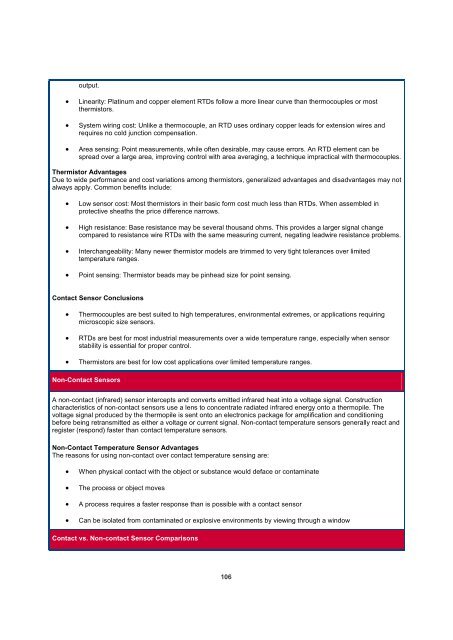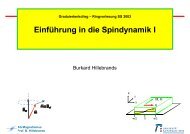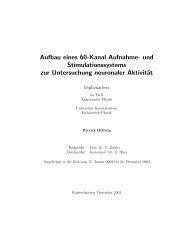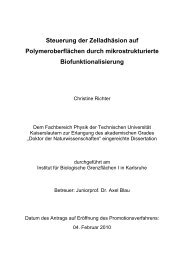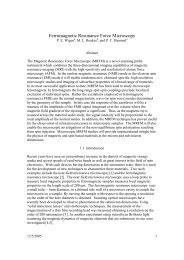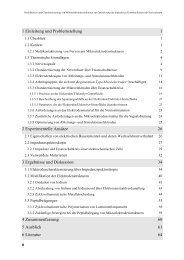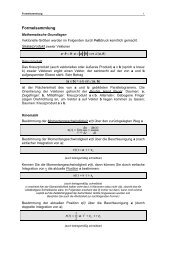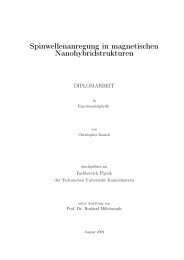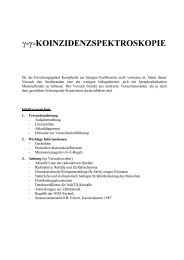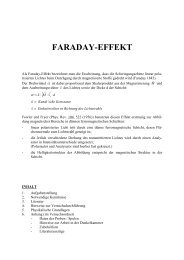Sensors and Actuators - Fachbereich Physik der Universität ...
Sensors and Actuators - Fachbereich Physik der Universität ...
Sensors and Actuators - Fachbereich Physik der Universität ...
Erfolgreiche ePaper selbst erstellen
Machen Sie aus Ihren PDF Publikationen ein blätterbares Flipbook mit unserer einzigartigen Google optimierten e-Paper Software.
output.<br />
• Linearity: Platinum <strong>and</strong> copper element RTDs follow a more linear curve than thermocouples or most<br />
thermistors.<br />
• System wiring cost: Unlike a thermocouple, an RTD uses ordinary copper leads for extension wires <strong>and</strong><br />
requires no cold junction compensation.<br />
• Area sensing: Point measurements, while often desirable, may cause errors. An RTD element can be<br />
spread over a large area, improving control with area averaging, a technique impractical with thermocouples.<br />
Thermistor Advantages<br />
Due to wide performance <strong>and</strong> cost variations among thermistors, generalized advantages <strong>and</strong> disadvantages may not<br />
always apply. Common benefits include:<br />
• Low sensor cost: Most thermistors in their basic form cost much less than RTDs. When assembled in<br />
protective sheaths the price difference narrows.<br />
• High resistance: Base resistance may be several thous<strong>and</strong> ohms. This provides a larger signal change<br />
compared to resistance wire RTDs with the same measuring current, negating leadwire resistance problems.<br />
• Interchangeability: Many newer thermistor models are trimmed to very tight tolerances over limited<br />
temperature ranges.<br />
• Point sensing: Thermistor beads may be pinhead size for point sensing.<br />
Contact Sensor Conclusions<br />
• Thermocouples are best suited to high temperatures, environmental extremes, or applications requiring<br />
microscopic size sensors.<br />
• RTDs are best for most industrial measurements over a wide temperature range, especially when sensor<br />
stability is essential for proper control.<br />
• Thermistors are best for low cost applications over limited temperature ranges.<br />
Non-Contact <strong>Sensors</strong><br />
A non-contact (infrared) sensor intercepts <strong>and</strong> converts emitted infrared heat into a voltage signal. Construction<br />
characteristics of non-contact sensors use a lens to concentrate radiated infrared energy onto a thermopile. The<br />
voltage signal produced by the thermopile is sent onto an electronics package for amplification <strong>and</strong> conditioning<br />
before being retransmitted as either a voltage or current signal. Non-contact temperature sensors generally react <strong>and</strong><br />
register (respond) faster than contact temperature sensors.<br />
Non-Contact Temperature Sensor Advantages<br />
The reasons for using non-contact over contact temperature sensing are:<br />
• When physical contact with the object or substance would deface or contaminate<br />
• The process or object moves<br />
• A process requires a faster response than is possible with a contact sensor<br />
• Can be isolated from contaminated or explosive environments by viewing through a window<br />
Contact vs. Non-contact Sensor Comparisons<br />
106


